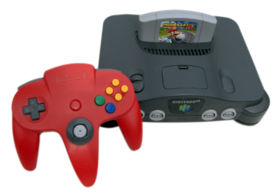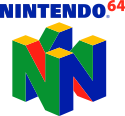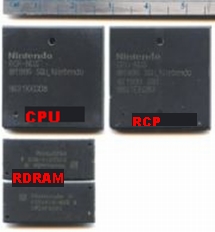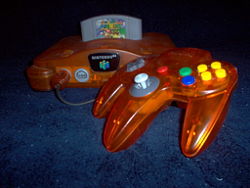Nintendo 64 console information
Nintendo 64

Nintendo 64 Console

- Manufacturer: Nintendo
- Type: Video game console
- Generation: 5th (32-bit/64-bit era)
- First Avaible:
- Japan: June 23, 1996
- North America: September 29, 1996
- PAL reigon: March 1, 1997
- France: September 1, 1997
- System Storage: Cartridge battery, Controller Pak
- Online service: RANDnetDD (Japan only)
- Units Sold:
- Worldwide: 32.93 million (as of March 31, 2005)
- Japan: 5.54 million
- Americas: 20.63 million
- Other: 6.75 million
- Top selling game: Super Mario 64, 11.62 million
- Predecessor: Super Nintendo Entertainment System (SNES)
- Successor: Nintendo GameCube
The Nintendo 64 often abbreviated as N64, was Nintendo's third home video game console for the international market. Named for its 32/64-bit processor, it was released on June 23, 1996 in Japan, September 29, 1996 in North America, March 1, 1997 in Europe and Australia, and September 1, 1997 in France (the system also saw a release in South America, in partnership with Gradiente Eletrônica S/A). It was released with two launch games (Super Mario 64 and Pilotwings 64) plus one in Japan (Saikyo Habu Shogi). The N64's suggested retail price was US$199 at its launch and it was marketed with the slogan: "Get N, or get Out!"
Development and introduction
Nintendo 64 was the culmination of work by Nintendo, Silicon Graphics, and MIPS Technologies. The SGI-based system design that ended up in the Nintendo 64 was originally offered to Tom Kalinske, then CEO of Sega of America by James H. Clark, founder of Silicon Graphics. SGI had recently bought out MIPS Technologies and the two companies had worked together to create a low-cost CPU/3D GPU combo that they thought would be ideal for the console market. A hardware team from Sega of Japan was sent to evaluate the chip's capabilities and they found some faults which MIPS subsequently solved. However, Sega of Japan ultimately decided against SGI's design, apparently in part due to internal problems between Sega of Japan and Sega of America.
Hardware
 The CPU powering Nintendo 64 is a MIPS R4300i-based NEC VR4300. The CPU is clocked
at 93.75 MHz and connects to the rest of the system through a 32-bit data bus.
VR43045 is a RISC 5-stage scalar in-order execution processor with an integrated
floating point unit. It is a 64-bit processor, in that it has 64-bit registers,
a 64-bit instruction set, and 64-bit internal data paths. However, the cost-reduced
NEC VR4300 CPU utilized in the console only has 32-bit buses whereas more powerful
MIPS CPUs are equipped with 64-bit buses. (In this respect the N64 CPU is
like the 32-bit Motorola 68000 which is considered a 16-bit architecture, due to
its bus limitation.) Many games took advantage of the chip's 32-bit processing
mode as the greater data precision available with 64-bit data types is not typically
required by 3D games. Also 64-bit data uses twice as much RAM, cache, and bandwidth
thereby reducing the overall system performance. This was later taken advantage
of by emulators such as the UltraHLE and Project64 that had to run on 32-bit Intel
systems. These emulators performed most calculations at 32-bit precision, and trapped
the few OS subroutines that actually made use of 64-bit instructions.
The CPU powering Nintendo 64 is a MIPS R4300i-based NEC VR4300. The CPU is clocked
at 93.75 MHz and connects to the rest of the system through a 32-bit data bus.
VR43045 is a RISC 5-stage scalar in-order execution processor with an integrated
floating point unit. It is a 64-bit processor, in that it has 64-bit registers,
a 64-bit instruction set, and 64-bit internal data paths. However, the cost-reduced
NEC VR4300 CPU utilized in the console only has 32-bit buses whereas more powerful
MIPS CPUs are equipped with 64-bit buses. (In this respect the N64 CPU is
like the 32-bit Motorola 68000 which is considered a 16-bit architecture, due to
its bus limitation.) Many games took advantage of the chip's 32-bit processing
mode as the greater data precision available with 64-bit data types is not typically
required by 3D games. Also 64-bit data uses twice as much RAM, cache, and bandwidth
thereby reducing the overall system performance. This was later taken advantage
of by emulators such as the UltraHLE and Project64 that had to run on 32-bit Intel
systems. These emulators performed most calculations at 32-bit precision, and trapped
the few OS subroutines that actually made use of 64-bit instructions.
Color variations
 The standard Nintendo 64 was dark gray, nearly black. A Jungle Green color was
first available with the Donkey Kong 64 bundle. The Funtastic Series used brightly-colored
translucent plastic. Nintendo released a banana-like Nintendo 64 controller for
the debut of Donkey Kong 64 in the United States. The Millennium 2000 controller,
available exclusively as part of a Nintendo Power promotional contest, was a
special silver controller in the United States. It is the only official Nintendo
64 controller to feature all black buttons. The first ever gold controller was
released by a contest from the Nintendo Power magazine as part of a drawing. One
was also released with shorter "arms" that for most made it hard to use. A gold
Nintendo 64 controller was packaged along with the GoldenEye 007 console pack in
the United Kingdom. Nintendo released a gold controller for the debut of The
Legend of Zelda: Ocarina of Time in Japan. Soon after, bundle packs of the game,
controller and gold Nintendo 64 were released for the US and PAL markets. The Pokémon
Edition Nintendo 64, with a Pokémon sticker on the left side, included the
"Pokémon: I Choose You" video. The Pokémon Pikachu Nintendo 64 had a large yellow
Pikachu model on a blue Nintendo 64. It has a different footprint than the standard
Nintendo 64 console, and the expansion port is covered. It also shipped with a
unique blue Pokémon controller, and orange in Japan. It is believed that the Limited
Edition Star Wars bundle, which was available only during time of release of
Star Wars Episode I: The Phantom Menace and came bundled with Star Wars: Episode
I Racer, and had what seemed like a differently colored dark black version of
the Nintendo 64. But it is actually the exact same dark gray color as the regular
Nintendo 64, and the "Limited Edition" on the box refers to the bundle itself,
not the console.
The standard Nintendo 64 was dark gray, nearly black. A Jungle Green color was
first available with the Donkey Kong 64 bundle. The Funtastic Series used brightly-colored
translucent plastic. Nintendo released a banana-like Nintendo 64 controller for
the debut of Donkey Kong 64 in the United States. The Millennium 2000 controller,
available exclusively as part of a Nintendo Power promotional contest, was a
special silver controller in the United States. It is the only official Nintendo
64 controller to feature all black buttons. The first ever gold controller was
released by a contest from the Nintendo Power magazine as part of a drawing. One
was also released with shorter "arms" that for most made it hard to use. A gold
Nintendo 64 controller was packaged along with the GoldenEye 007 console pack in
the United Kingdom. Nintendo released a gold controller for the debut of The
Legend of Zelda: Ocarina of Time in Japan. Soon after, bundle packs of the game,
controller and gold Nintendo 64 were released for the US and PAL markets. The Pokémon
Edition Nintendo 64, with a Pokémon sticker on the left side, included the
"Pokémon: I Choose You" video. The Pokémon Pikachu Nintendo 64 had a large yellow
Pikachu model on a blue Nintendo 64. It has a different footprint than the standard
Nintendo 64 console, and the expansion port is covered. It also shipped with a
unique blue Pokémon controller, and orange in Japan. It is believed that the Limited
Edition Star Wars bundle, which was available only during time of release of
Star Wars Episode I: The Phantom Menace and came bundled with Star Wars: Episode
I Racer, and had what seemed like a differently colored dark black version of
the Nintendo 64. But it is actually the exact same dark gray color as the regular
Nintendo 64, and the "Limited Edition" on the box refers to the bundle itself,
not the console.
Cartridge-copy counter-measures
Each Nintendo 64 cartridge contains a so-called lockout chip (similar in spirit to the 10NES) to prevent manufacturers from creating unauthorized copies of games, and to discourage production of unlicensed games. Unlike previous versions, the N64 lockout chip contains a seed value which is used to calculate a checksum of the game's boot code. To discourage playing of copied games by piggybacking a real cartridge, Nintendo produced five different versions of the chip. During the boot process the N64 would compute the checksum of the boot code and verify it with the lockout chip in the game cartridge, failing to boot if the check failed. Some games, such as Banjo Tooie, perform additional checks while running.
Cartridges vs. discs in home game consoles
The Nintendo 64 was the last mainstream home video game console to use masked ROM cartridges to store its games (although the last cartridge based system to have still continued production was actually SNK's Neo Geo hardware until 2004).
Advantages
Nintendo cited several advantages for making the N64 cartridge-based:- ROM cartridges have very fast load times in comparison to disc based games, as contemporary CD-ROM drives rarely had speeds above 4x. This can be observed from the loading screens that appear in many Sony PlayStation games but are typically non-existent in N64 versions. ROM carts are so much faster than the 2x CD-ROM drives in other consoles that developers could stream data in real-time off them. This was done in Indiana Jones and the Infernal Machine, for example, to make the most of the limited RAM in N64.[14] One could describe the ROM as an additional amount of slow RAM, similar to virtual memory in a modern operating system. One Nintendo magazine ad placed a Space Shuttle (cartridge) next to a snail (a CD) and dared consumers to decide "which one was better".
- ROM cartridges are difficult and expensive to duplicate, thus resisting piracy, albeit at the expense of lowered profit margin for Nintendo. (Nintendo had likely weighed the trade-offs and concluded that reducing losses from piracy would offset higher cartridge production costs.) While unauthorized interface devices for the PC were later developed, these devices are rare when compared to a regular CD drive and popular mod chips as used on the PlayStation. Compared to the N64, piracy was rampant on the PlayStation.
- It is possible to add specialized support chips (such as co-processors) to ROM cartridges, as was done on some SNES games (notably Star Fox, using the Super FX chip).
- Most cartridges store individual profiles and game progress on the cartridge itself, eliminating the need for separate memory cards. Storing data at first required a cartridge battery whose energy would diminish over time, though the battery generally lasted for years, and in subsequent games EEPROMs were used instead.
- ROM cartridges are far more durable than CD-ROMs. It is extremely difficult to damage a cartridge, whereas compact discs must be carefully used and protected in cases. This makes the cartridges better for children who do not know how to take care of CD-ROMs. It also prevents accidental scratches even by adult owners, and subsequent read errors from these inevitabilities.
- It was also a frequent occurrence for the mechanisms of early CD-ROM drives to fail. There are no moving parts with a ROM cartridge system.
Disadvantages
- While game cartridges are more resistant than CDs to mechanical damage, they are sometimes less resistant to long-term environmental damage, particularly oxidation or wear of their electrical contacts. (The cartridges for Nintendo's earlier NES system were particularly notorious for this.)
- Console cartridges are usually larger and heavier than optical discs and hence take up more room to store.
- More complex manufacturing processes meant games were usually more expensive than their optical counterparts (some titles were US$70.00 in price.)
- Cartridges store significantly less data than CDs. As fifth generation games became more complex in content, sound, and graphics, it pushed cartridges to the limits of their storage capacity.
- Games ported from other media had to use data compression or reduced content in order to be released on the N64.
- Extremely large games could be made to span across multiple discs on CD based systems, while cartridge games had to be contained within one unit since using an additional cartridge was prohibitively expensive (and was never tried).
- Because of a cartridge's space limitations, full motion video was not usually feasible as on CDs (although the N64 version of Resident Evil 2 did feature full motion video) for use in cut-scenes.
Graphics
Graphically, results of the Nintendo cartridge system were mixed. The N64's graphics chip was capable of trilinear filtering, which allowed textures to look very smooth compared to the Sega Saturn and the Sony PlayStation; neither could provide better than nearest neighbor interpolation, resulting in textures that were highly pixelated. However, the limited storage size of ROM cartridges limited the number of available textures, resulting in games which had blurry graphics because of the liberal use of stretched, low-resolution textures, which was compounded by the N64's 4096-byte limit on a single texture. Some games, such as Super Mario 64, use a large amount of Gouraud shading or very simple textures to produce a cartoon-like look. This fit the themes of many games, and allowed this style of imagery a sharp look while hiding the texturing limitations of the machine. Later cartridges such as Resident Evil 2 featured more ROM space, which demonstrated that N64 was capable of detailed in-game graphics when the media permitted, though this came at an expense.
Screenshot of Super Mario 64, showing limited texture detail and Gouraud shading (Mario himself). The trees are two dimensional and always facing the camera.
Assessories

The controller memory pak

4MB expansion pak

Nintendo 64 Transfer Pak will plug into the controller and transfer Gameboy Color data to the Nintendo 64 game that is compatible with it.

The Nintendo 64 Disk Drive was a commercial failure and was never released outside Japan.
Did this information help you? (30 letters only)
